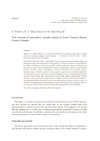Identificador persistente para citar o vincular este elemento:
https://accedacris.ulpgc.es/jspui/handle/10553/75493
| Campo DC | Valor | idioma |
|---|---|---|
| dc.contributor.author | Verloove, F. | en_US |
| dc.contributor.author | Déniz Suárez, Eliseo A. | en_US |
| dc.contributor.author | Salas Pascual, Marcos | en_US |
| dc.date.accessioned | 2020-11-12T19:49:39Z | - |
| dc.date.available | 2020-11-12T19:49:39Z | - |
| dc.date.issued | 2020 | en_US |
| dc.identifier.issn | 1120-4052 | en_US |
| dc.identifier.other | Scopus | - |
| dc.identifier.uri | https://accedacris.ulpgc.es/handle/10553/75493 | - |
| dc.description.abstract | Recent field work by the authors on the island of Gran Canaria (Canary Islands, Spain) yielded new interesting records of non-native species. Seven species, i.e. Centaurea sulphurea, Clematis flammula, Fallopia baldschuanica, Fraxinus angustifolia, Melilotus officinalis, Saponaria officinalis, and Searsia lancea have not been recorded before from the Canary Islands, whereas 13 species (Bellis perennis, Centaurea diluta, Chlorophytum comosum, Chondrilla juncea, Cyperus papyrus, Delphinium ajacis, Helianthus annuus, Lonicera japonica, Lupinus pilosus, Montanoa bipinnatifida, Ornithogalum arabicum, Trifolium cernuum, and Wigandia caracasana) are reported for the first time from Gran Canaria. The actual presence of five further species (Chenopodium vulvaria, Fallopia convolvulus, Kalanchoe daigremontiana, Paspalum dilatatum, and Volutaria tubuliflora) - all considered doubtful, recently discovered or with only historical occurrences in Gran Canaria - is confirmed. Chorological and ecological details are presented for these species and their invasion status is assessed. Many of them are reputed weeds, either agriculturally or environmentally. | en_US |
| dc.language | eng | en_US |
| dc.relation.ispartof | Flora Mediterranea | en_US |
| dc.source | Flora Mediterranea [ISSN 1120-4052], v. 30, p. 121-136, (Agosto 2020) | en_US |
| dc.subject | 2417 Biología vegetal (botánica) | en_US |
| dc.subject.other | Alien Flora | en_US |
| dc.subject.other | Floristic Inventories | en_US |
| dc.subject.other | Xenophytes | en_US |
| dc.title | New records of non-native vascular plants in Gran Canaria (Spain, Canary Islands) | en_US |
| dc.type | info:eu-repo/semantics/Article | en_US |
| dc.type | Article | en_US |
| dc.identifier.doi | 10.7320/FLMEDIT30.121 | en_US |
| dc.identifier.scopus | 85092790540 | - |
| dc.contributor.authorscopusid | 56044794900 | - |
| dc.contributor.authorscopusid | 57219350433 | - |
| dc.contributor.authorscopusid | 57219453658 | - |
| dc.identifier.eissn | 2240-4538 | - |
| dc.description.lastpage | 136 | en_US |
| dc.description.firstpage | 121 | en_US |
| dc.relation.volume | 30 | en_US |
| dc.investigacion | Ciencias | en_US |
| dc.type2 | Artículo | en_US |
| dc.utils.revision | Sí | en_US |
| dc.date.coverdate | Agosto 2020 | en_US |
| dc.identifier.ulpgc | Sí | en_US |
| dc.contributor.buulpgc | BU-BAS | en_US |
| dc.description.sjr | 0,361 | |
| dc.description.sjrq | Q3 | |
| item.grantfulltext | open | - |
| item.fulltext | Con texto completo | - |
| crisitem.author.dept | GIR IUNAT: Biología Integrativa y Recursos Biológicos | - |
| crisitem.author.dept | IU de Estudios Ambientales y Recursos Naturales | - |
| crisitem.author.orcid | 0000-0003-2882-4469 | - |
| crisitem.author.parentorg | IU de Estudios Ambientales y Recursos Naturales | - |
| crisitem.author.fullName | Salas Pascual, Marcos | - |
| Colección: | Artículos | |
Citas SCOPUSTM
5
actualizado el 08-jun-2025
Visitas
358
actualizado el 31-may-2025
Descargas
242
actualizado el 31-may-2025
Google ScholarTM
Verifica
Altmetric
Comparte
Exporta metadatos
Los elementos en ULPGC accedaCRIS están protegidos por derechos de autor con todos los derechos reservados, a menos que se indique lo contrario.
